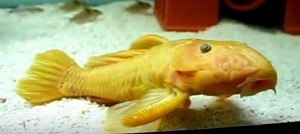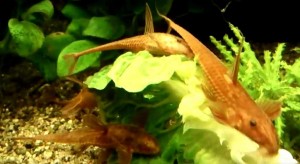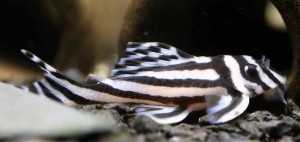Rubber Plecostomus (Parancistrus aurantiacus) are also commonly known as Chubby Plecos, Rubber Plecos or Gold Finned Suckermouths. They are a relatively long lived (10 years or more), algae eating, South American suckermouth catfish that are popular with tropical fish keeping enthusiasts who keep them as “housekeepers” for community aquariums.
The Rubber Plecostomus is found in the fast moving South American rivers and tributaries of the Río Ucayali, in Peru and Brazil.
Rubber Plecos have bristles on both sides of their mouth and under their eyes. Their scales are tan to dark brown outlined in black, however, their colors vary wildly and specimens can be anywhere from dark brown to gold, depending on their mood and stress level. As a general rule their color darkens when they are severely stressed.
The Rubber Plecostomus (Parancistrus aurantiacus) is sometimes confused with the more common Trinidad pleco (Hypostomus plecostomus) or the rubbernose or bulldog pleco (Chaetostoma spp) however Rubber Plecos do not grow as large as their other suckermouth catfish, Loricariidae family relatives.
Rubber Plecostomus are efficient algae eaters, which is why they are so sought after for community aquariums to help control algae.
Rubber Plecos are a peaceful fish and make a good addition to any community aquarium. They are not picky eaters and will get most of their nutrition from algae in the tank and left over food on the bottom of the aquarium. Although they are omnivores and thrive on a vegetable based diet, they should occasionally be given a supplement of freeze dried bloodworms, a high quality flake food, sinking carnivore pellets, or tubifex
.
Rubber Plecos need a large, (55 gallon minimum) heavily aerated tank, planted with hearty, fast growing plants, and lots of water movement. Aquascape the tank with rocks and driftwood to provide them with plenty of hiding places and to mimic their natural environment.
The Rubber Plecostomus has not been bred in captivity and their breeding habits have not yet been documented. Sexing the Rubber Pleco is difficult but males have thicker spines on the first hard ray of their pectoral fins.
When available for purchase they are approximately 2″ to 4″ long.
Minimum Tank Size: 55 gallons
Care Level: Easy
Temperament: Peaceful
Aquarium Hardiness: Hardy
Water Conditions: 72-78° F, KH 8-12, pH 6.5-7.5
Max. Size: 7″
Color Form: Black, Yellow
Diet: Omnivore
Origin: South America
Family: Loricariidae
Life Span: 10 + years
Aquarist Experience Level: Intermediate






